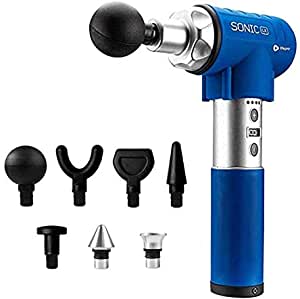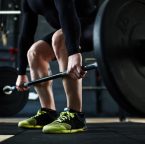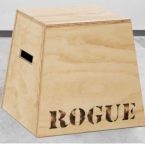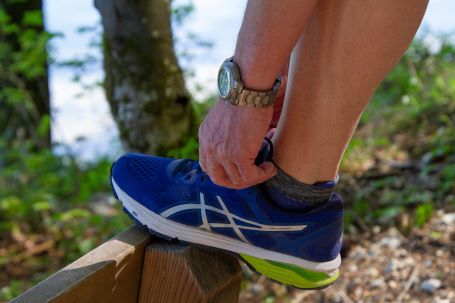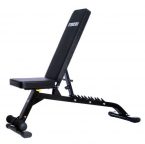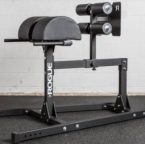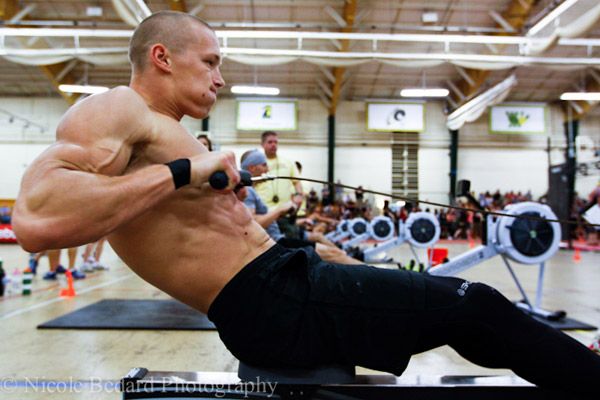A foam roller is perhaps the simplest massage tool ever created. Even operating one is fairly easy- just apply it to the muscle, then stop when you hit a sore or tender spot. The roller puts pressure on the ‘knots’, or adhesions and with repeated use can ‘untie’ them, so to speak.
Regular foam rolling alleviates muscle soreness and shortens the recovery period, which means you can go back to training sooner. A lot of people, including your favorite fitness personality and athlete may already be using them to get better at the end of the day, so why not you?
Today we’ll talk about the virtues of the humble foam roller and the foam rolling benefits. We will also discuss how you can make the most of your time with it and learn how to roll properly.
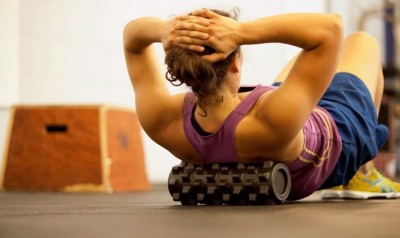
Related: Best Massage Guns for Athletes
Foam Rolling Benefits
Muscle Tightness and Pain Reduction
Like any good massage tool, a foam roller can work wonders in alleviating muscle tightness and the pain that it brings.
Muscle tightness or ‘knots’ are bunched-up tissue that gather in one painful spot. When you put pressure on it, the fascia, or fibrous tissue that’s adjacent to your muscle gets stimulated, scatters and becomes more mobile.
Regular foam rolling keeps both muscle and fascia loose and flexible, thus preserving the original range of motion and improving your physical mobility. Plus, adhesions will be less likely to form since you’re breaking them up as it happens.
Now, you could be wondering if stretching can do the same thing. Unfortunately, what we’re told isn’t always true. Experts warn against stretching as it can actually add to the muscle tightness and knotting. If you want to be sure, stick to foam rolling to improve flexibility and restore range of motion.

Better Mobility
A higher level of mobility is always a plus in our books, something the ol’ foam roller can bring to the table.
Without sounding like a broken record, here’s how it is. If you want greater or restored muscle mobility you’ll have to pay attention to your fascia adhesions. In other words, these knots get in the way of overall flexibility.
Here’s a real-life example. Knots in the hip or glutes will mean an impaired performance when squatting, and when you spend time getting those kinks out with a foam roller you can experience restored mobility. The good news is that you can even carry out movements that you were having difficulty before.
It’s easy to believe that your body may never be as flexible as you want it to be, but this isn’t always the case. There’s a chance that it’s shortened muscles, but there’s also a chance that fascia adhesion is keeping you from realizing your movement potential.
Unlimited Massages Anytime
A deep tissue massage works wonders against those tight, sore muscles. Foam rollers actually do the same thing, but with one exception- no one will do it for you.
Once you get over that hump though, you’ll find that there are benefits to using a foam roller instead of a traditional massage. For one, you can save money and get ‘free’ massages (as long as you’re up for it!), and two, you can do it anywhere (as long as you have ample space).
Work up the habit of regular rolling and your muscles won’t reach the point where it can’t be ironed out in one session. Plus, you won’t ever have to pay for a deep tissue massage again!
Relief For Your Body and Mind
Prolonged fascia and adhesion can put a toll on your body. Your muscles won’t be in optimal shape, and performance will likely suffer. Suffice to say, you should take the time and reduce these tensions and relieve the stress that comes from it.
Rolling allows you to regularly reap both physical and mental stress that comes with knotted muscles.
Foam Rolling: How to Get Started
Foam rolling may seem stupidly simple but there’s actually a lot going on. It’s easy to assume you know how to use a foam roller, but then you’ll be wasting time and not getting the results you want from these things.
Here are a few rules on how to roll properly:
- Don’t roll your bone or joint.
- Do a quick check on which areas are sore by following the right hip hinge screening and squat screening.
- You’ll know you’re doing it right when you’re using bodyweight to apply pressure. Scan by rolling slowly, then when you hit an adhesion stop, then stay there for half a minute on the adhesion. Then, resume rolling until all the spots are covered.
- It’s okay to do foam rolling multiple times in a day. In fact, we’d recommend using it to iron out problem areas and keep them loose and limber.
- It’s also okay to use a roller as a warmup tool during the pre-workout phase, as well as afterward for better muscle recovery.
The internet has some very good tutorials on foam rolling and keeping in form for maximum effect. Do the screening process to identify areas of improvement, then map out a routine to target these areas for muscle relief and stimulation.
Some of the most common roll areas include the hip flexor, the chest, the IT band, hips and the piriformis muscle, which is thought to relieve hip pain and sciatica.
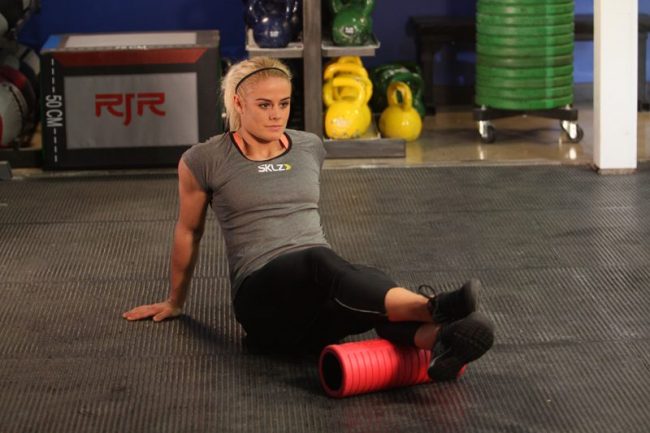
Step by Step Foam Rolling Technique
Step 1. Identify the sore muscle and have the foam roller ‘feel’ out which area is sore and needs treatment. Roll slowly until you hit a sore spot, then stop and keep the roller on it for about 30 seconds. With enough pressure, the adhesion dissipates and the tenderness should be reduced. Continue rolling until you’ve ironed out the knots. As a general rule, don’t put pressure on the point for more than half a minute. Go back to it the next day or later at night.
Step 2. Be careful and don’t ever let the foam roller reach or put pressure on your lower back, or on any bones in your body.
Step 3. You could be wondering, ‘how often can I do foam rolling?’. The answer is that it’s generally acceptable to roll every hour, or several times during the day. Additionally, you should only roll when you’re comfortable and when the fascia is still there. Also, do what bodybuilders and athletes do with their foam rollers- they use it before workouts as a warming up tool, and after workouts for better muscle recovery.
Step 4. The best foam roller for you is one that works well and fits your need. The most expensive roller isn’t always the best, and the same goes for the most popular one. Take the time to read up on the features and see if it’s a good fit for you. Even a PVC pipe of considerable length can act as a litmus test to get you acquainted.
How to Build a Foam Rolling Routine
Before rushing out to buy a quality foam roller, stop and think- which areas do you think you need the most help with?
To answer this, take a mobility screening test and write down the results in your phone or a notebook. Add a few of your goals as well- do you want to be better at squat movements, or gain a greater range of motion on your hips?
As you navigate through these suggestions then a routine will slowly start to take shape.
If nothing comes to mind then here are a few routine programs you may want to adopt. We’ll also show you what muscle or movement it can benefit.
Suffering from hip or ankle mobility? Not a problem. Carry out a hip mobility screening to confirm the areas of opportunity. It’s okay to fail- this means that your hip flexors and glutes will need regular rolling, combined with lunges and other hip-stretching exercises.
Having issues with squat mobility? Here’s a simple way to find out. Do a squat and hold it mid-position. If you inadvertently round your back or if your heels are off the ground then this is a legitimate area of improvement. For this it’s best to apply the foam roller to the calves and hips and adding ankle mobility in the mix. For the best results, take some time and work on your core as well.
For those who are experiencing sciatica, here’s a routine for you. The condition is likely caused by your sciatic nerve being pressed onto something else, and can be relieved by targeting the piriformis and the hip flexors. It’s recommended for individuals who are constantly battling pain in the buttocks and lower back area.
Adhesions on your shoulder? Then this should do the trick. Take out those ‘knots’ by putting a tennis ball into a sock and slinging it on your shoulder. Put the ball between your shoulder and a solid wall and apply pressure until the adhesions disappear. In this position you can control where the ball goes and how much pressure gets applied. Alternately, you can use the floor and lie down to get the roll. Otherwise, a foam roller offers wider coverage.
Types of Foam Rollers
All foam rollers are not the same here are the different kinds you can choose from:
The Knobby Kind
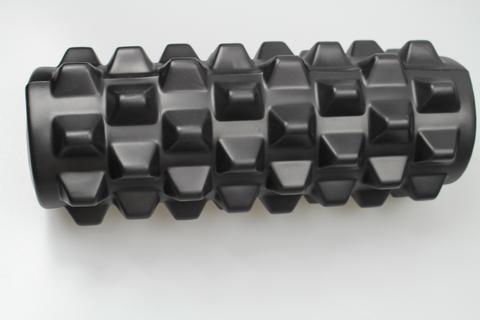
While it may look like some kind of torture device, the knobby foam rollers are great. Instead of a smooth surface, they have knobs to help you get those trigger points and adhesions. These are great for people who have knots in their upper back and it isn’t as painful as it looks to use.
See this knobby roller on Amazon
High-Density Foam Rollers

The high-density foam roller is probably what most people think when they think about a foam roller. This is a firmer foam that provides good resistance. These are ideal for the entire body but I really like to use them on the outer hips.
See this high-density foam roller on Amazon
Low-Density Foam Rollers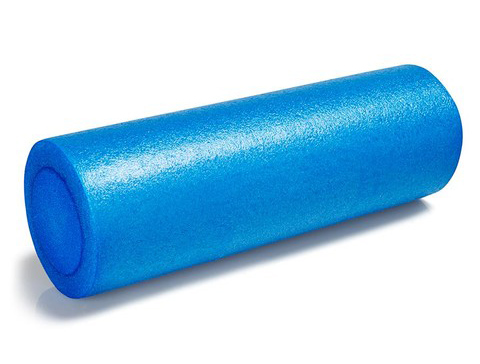
This one looks just like the high-density foam but it’s not the same. It is a softer and more pillowy type of foam. If you go from a high density to a low-density foam roller you will definitely notice the difference. These are good for people who are sensitive to or think the high-density foam is too painful.
See this low-density foam roller on Amazon
Grid Rollers
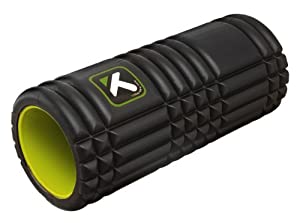
These are firm rollers that have grid patterns on them for extra penetration. Honestly, I have never really noticed much of a benefit from the grids on these rollers but I do like how firm they are which makes them quite useful in my opinion.
See this grid foam roller on Amazon
Contoured Foam Roller

There is also the contoured roller. This roller allows you to get deep penetration where is needed. It is designed to massage while avoiding contact with the spine, shoulder blades, hips, IT band, Achilles, & tibia/shins to prevent damage and discomfort. This is definitely a good option for those looking to get deep penetration.
See this contoured foam roller on Amazon
Home Made Foam Rollers
Let’s be honest, it is quite possible to make your own roller or just use something you have around the house.
You could cut up a pool noodle down and shove a 1 inch PVC pipe inside of it. You could also use a rolling pin, a wooden dowel, a piece of PVC pipe all by itself, a water bottle, tennis ball, lacrosse ball or anything else that you can think of.
I have even used the edge of a step before when I didn’t have anything else.
What I Use
Personally, I get a lot of knots in my upper back and have tight outer hips. For these, I use 2 different rollers.
I use a knobby roller on my upper back and a homemade roller for my hips. My homemade roller is actually a 4-inch diameter cardboard tube that used to be on the inside of a roll of fabric. It is thick cardboard that is very firm and works great on the hips and legs. It doesn’t work well on the upper back though. I have also used the high-density foam rollers they had at the gym with good success. I prefer the cardboard tube though because it is even more firm. Since most of you can’t come across a cardboard tube thick enough that you won’t crush it I would recommend a 4″ PVC pipe, it provides about the same firmness. The firmer the better, in my opinion, hurts so good.
Conclusion
Now you know just about everything there is to know about the foam rolling benefits, how to do it as well as the different kinds of foam rollers. And you also know why you should be foam rolling if you aren’t already.

Ryan is a former college wrestler and lifelong fitness fanatic. He has run half marathons, done mud runs, placed in body transformation contests, coached wrestling, and now coaches girls’ soccer. Not to mention he has also tried literally hundreds of supplements over the years and has a vast and thorough supplement knowledge. He has written for Muscle & Strength, Testosterone Junkie, The Sport Review and other publications. He is also the editor-in-chief of this website and has over 25 years of experience in the fitness industry. Feel free to connect with him on his LinkedIn page below.

